Report
FOLENS Seminar in October (17-19 October) Visiting CBD-COP10 in Nagoya
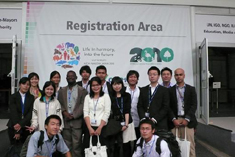 |
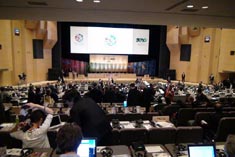 |
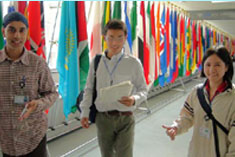 |
Group Work Reports
Group A:NGOs' roles on biodiversity conservation: From conflict to consensus![]()
Group D:Investigation of standpoints for genetic resource use between developed and developing countries ![]()
==================================================
Human-beings are part of nature. Existence and activities of the human society are sustained by biological resources. Variation of biological species in richness and evenness, that is biological diversity, is necessary for sustaining biological resources as the biological system works in relationships under biological diversity. Therefore, biological diversity is a global asset to conserve for present and future generations. The threat to biological diversity, however, has been a growing concern and species extinction caused by human activities continues at an alarming rate. In response, United Nations Convention on Biological Diversity (CBD) was initiated by United Nations Environmental Programme (UNEP) in November 1988, formalized in the Earth Summit in Rio de Janeiro in 1992, and entered into force on 29 December 1993. The convention has three main objectives:
1. The conservation of biological diversity
2. The sustainable use of the components of biological diversity
3. The fair and equitable sharing of the benefits arising out of the utilization of genetic resources
Meetings of the convention among stakeholders, that is called Conference of the Parties (COP), have been held bi-annually (although the first three COPs were annually) since December 1994 of COP1 at Nassau, Bahamas. The 10th COP of CBD (CBD-COP10) was called and organized in Nagoya City, Aichi Prefecture, Japan, for two weeks from 18 to 29 October 2010. The CBD-COP10 was coinciding with both the date of the final year of the ‘2010 Biodiversity Target’ of CBD which was committed in April 2002 and the ‘2010 International Year of Biodiversity’ which was proclaimed by the United Nations in 2006. The agenda and prospects of the meeting, therefore, attracted much international attention.
As the October FOLENS Seminar, students and faculties of FOLENS visited COP10 in Nagoya for three days from Sunday 17th to Tuesday 19th of October 2010. This experience was supposed to provide an insightful and useful opportunity for the FOLENS students of future leaders in environmental sectors. Objectives of the visit were as follows:
1. To become familiar with an international convention and experience its conference
- What? - To get used to a style of international diplomatic documents
- How? - To understand the process of dialogues to work out international agreements
- Who? - To realize stakeholders of international environmental conventions
2.To get familiarized with the concept of ‘biodiversity’ and think about roles of natural and social sciences
- What biological diversity means and how it can be measured
- Why biological diversity? – its background and related issues
- Scientific justification of the concept and arguments
3. To understand arguments (points) in the conference and think about the roots and solution of the arguments
- Reduction of biodiversity loss and degradation – Post 2010 targets
- Access and benefit-sharing (ABS) of genetic resources
In the pre-session of the visit in the September FOLENS Seminar, students formed four work-groups and set out a survey topic and approach of a group. Titles of the survey topic are as follows and their reports after the survey are attached above:
Group A: NGOs' roles on biodiversity conservation: From conflict to consensus
Group B: The importance of agricultural biodiversity and how to approach to 2020 target from its sector: What is agricultural biodiversity?
Group C: Comparison of approaches of developed countries with developing countries in applying biodiversity convention into practice
Group D: Investigation of standpoints for genetic resource use between developed and developing countries
Day 1. Students and faculties (hereinafter referred to as ‘the members’) received priority-pass cards with a status of ‘Observers’, based on the official registration prior to the meeting. The ‘Observer’ status guaranteed the members access to the conference halls, the side-event meeting rooms, and the welcome reception. The members visited all the three sites, Shiratori, Nagakute, and Sakae, of the meeting to overview the meeting set-up.
Day 2. Group survey started. Many of the members attended the opening ceremony of the meeting. Started by a brilliant shadow-play show with an impressive-sounding bamboo flute, environment ministers (they were the chairmen of the previous and present meetings) and director-generals of UN provided speeches on which the members made various comments afterwards. During lunch time between morning and afternoon sessions, a series of side-events were organized for presentation of activities, analyses (to a lesser extent) and opinions, as well as for exchange of information, views and specific strategy of process for the negotiation in the meeting. The students were eager to obtain information from the presentations and to communicate with experts related to the survey topics of the group work. Just outside of the conference venue, the Interactive Fair of Biodiversity, which people without official registration can visit, was arranged by a number of booths prepared by various civic groups, organizations, institutions, and companies who wished to present their activities and ideas. An additional task was given to students there; that was to observe the booths in the Interactive Fair and pick up good ones in terms of contents, presentation and hospitality. This ‘contest’ was supposed to be an opportunity for students to think about what makes good presentation in such occasions. The welcome reception by the Japanese Government seemed also a unique experience for the members in observing arrangements of foods and drinks for over 1,000 people and elegant-looking Japanese receptionists.
Day 3. The survey of the work-groups began from early morning (some NGOs provided a briefing of the day in the morning) and continued until late afternoon. The students, who had been familiarized with the venue, structure and documents of the meeting, seemed accelerated their survey activities. Then in the late afternoon, the members had a wrap up meeting on the lawn of the Interactive Fair site. Although comprehensive results would be presented in the review session in the November FOLENS Seminar, brief contents of the survey results as well as fresh impressions of the CBD-COP10 were talked by each work-group and some of the students, respectively. Comments of the students suggested they felt this opportunity useful and interesting for understanding the international framework of activities related to biodiversity (activities related to ‘environment’, more in general), in which they would be involved in their future.
Conferences on international conventions such as CBD-COP are opportunities not only for diplomats to negotiate contents of the convention documents but also, quite importantly, for various stakeholders to present activities, analyses and opinions, to exchange information and views, and to extend human relationships; that is, the opportunities of communication for various people concerned about the objective of the convention, that is ‘conservation of local and global biodiversity’ for the CBD-COP10’s case. A comment by a participant plainly explains: ‘this is like an academic conference.’ The communication is the power-source of the negotiation and is virtually shaping the present world and Earth. (tf)
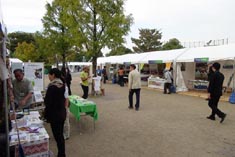 |
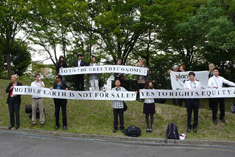 |
 |